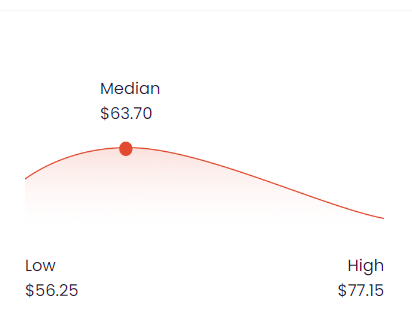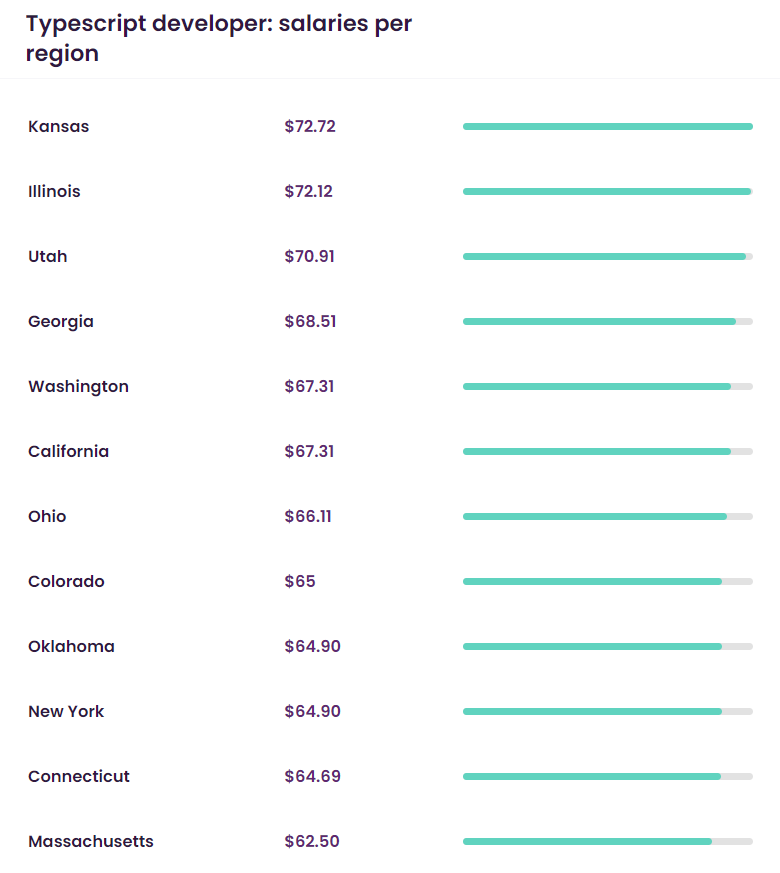TypeScript Developer Hourly Rate Breakdown
In the United States, the average hourly rate for developers in the Typescript job category stands at $58.91. A closer look at the salary distribution reveals that a significant majority earn between $53.08 (representing the 25th percentile) and $64.28 (marking the 75th percentile). This data provides a snapshot of the typical hourly rate range for TypeScript developers in the country.
Table of Contents
It is important to be aware of the current rates for the skill before you start to hire TypeScript developers for your project. Whether you’re a seasoned TypeScript developer looking to gauge your market value or an employer planning to hire TypeScript talent, this guide offers a comprehensive overview of the current pay rates in this field.
What’s the Average TypeScript Developer Earning Hourly?
Across the platforms Glassdoor, ZipRecruiter, and Talent.com, there’s a noticeable trend in how they rate developer salaries based on experience levels. Glassdoor tends to offer slightly lower estimates for all experience tiers when compared to the other two platforms.

ZipRecruiter’s estimates are consistently in the middle range, with Talent.com generally presenting the highest salary estimates, especially for senior developers where the difference is most pronounced. This variance underscores the importance of cross-referencing multiple sources when researching or negotiating salaries.
How TypeScript Hourly Rates Differ by Region
Here’s a list of estimated hourly rates for TypeScript developers across various locations:
| Region | Average Hourly Rate (USD) |
|---|---|
| North America | $50 - $65 |
| South America | $20 - $35 |
| Western Europe | $40 - $55 |
| Eastern Europe | $25 - $45 |
| Australia | $45 - $60 |
| Asia | $15 - $40 |
| Africa | $10 - $30 |
The TypeScript developer hourly rates exhibit a broad spectrum when viewed globally. North America, stands out with the highest rates, reflecting its mature tech industry and high demand for specialized skills. Western Europe and Australia follow closely, offering competitive rates due to their developed tech ecosystems.
Eastern Europe, known for its tech talent, offers a balance of affordability and expertise. South America, Asia, and Africa typically present lower rates, influenced by factors such as cost of living, local economies, and the developing stage of their tech industries. It’s important for businesses and developers alike to consider these factors alongside skill levels and project requirements when navigating the global TypeScript job market.
Statistics from talent.com suggest that even in the United States, the hourly rate obtained by a TypeScript developer varies according to the state. The highest salary is obtained by developers in Kansas, followed by developers in Illinois, Utah, Georgia, Washington, California, Ohio, Colorado, Oklahoma, and New York coming in tenth place.
Further, talent.com details that in the United States, the average hourly rate for a TypeScript developer is $63.70 per hour. Entry-level positions start at $56.25 per hour, while the most experienced workers can earn up to $77.15 per hour.


Comparing TypeScript’s Hourly Rates with Other Open-Source Programming Languages
Here’s an approximate breakdown of hourly rates for developers skilled in various open-source programming languages:
| Programming Language | Average Hourly Rate (USD) |
|---|---|
| C++ | $30 - $65 |
| Java | $30 - $70 |
| JavaScript | $35 - $65 |
| PHP | $25 - $50 |
| Scala | $45 - $75 |
| R | $40 - $70 |
| Python | $30 - $75 |
| Kotlin | $50 - $75 |
| Swift | $50 - $80 |
| Elixir | $40 - $70 |
| Haskell | $40 - $65 |
The programming landscape presents a wide array of hourly rates, mainly dictated by market demand and the applicability of each programming language. Web-centric languages like TypeScript and JavaScript generally have competitive rates due to their centrality in the digital realm. On the mobile front, Kotlin and Swift command higher rates owing to their respective Android and iOS specializations.
Languages like Python, with its vast applications, have a broader rate range. On the other hand, niche or specialized languages like Haskell and Elixir might fetch higher rates but might have less overall demand. Traditional and foundational languages like Java and C++ continue to maintain competitive rates due to their common use in various sectors.
Conclusion
This blog post provides a detailed look at the compensation landscape for TypeScript developers. It highlights how hourly rates are influenced by factors such as experience, geographical location, and project complexity. This guide is a valuable asset for TypeScript developers assessing their earning potential and for employers seeking to understand the going rates for this skill set. Overall, it emphasizes the growing demand for TypeScript expertise in the tech industry and the corresponding pay trends, offering a key reference point for those navigating the financial aspects of TypeScript development.
You can check out our TypeScript Developer Annual Salary Guide to learn about the annual salary rates you can earn in the US and across the world. We bring you a complete TypeScript Developer Hiring Guide, along with the TypeScript Developer Job Description and TypeScript Developer Interview Questions guide which will help you in the process of hiring a TypeScript developer in 2023.
Table of Contents









